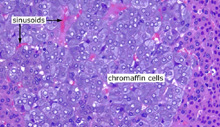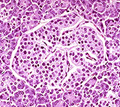 Addison’s
disease is an adrenal insufficiency caused by infection or
autoimmune destruction of the adrenal cortex. Fatigue, low blood
pressure, nausea and other symptoms of the disorder suggest failure
of secretion of both glucocorticoids and mineralocorticoids. Addison’s
disease is an adrenal insufficiency caused by infection or
autoimmune destruction of the adrenal cortex. Fatigue, low blood
pressure, nausea and other symptoms of the disorder suggest failure
of secretion of both glucocorticoids and mineralocorticoids.
On slide 20 examine the
medulla and
identify the clumps of larger cells, sometimes called chromaffin
cells (Fig. 20-16). These cells have same neural crest
origin embryologically and are somewhat similar histologically to
the autonomic ganglia found in the gastrointestinal tract. Note also the large vascular sinuses present
in the adrenal medulla.
gastrointestinal tract. Note also the large vascular sinuses present
in the adrenal medulla.
What do cells of the adrenal
medulla secrete?
What histological features of
the medullary chromaffin cells are similar to cells of an autonomic
ganglion?
 Pancreatic islets (of Langerhans) --
contain several types of peptide hormones, mostly insulin and
glucagon. Pancreatic islets (of Langerhans) --
contain several types of peptide hormones, mostly insulin and
glucagon.
Examine a section of pancreas (slides
154 and
44) and identify the
islets of Langerhans (Fig. 20-17). Note the histological differences from pancreatic
acinar tissue and the similarities to other endocrine tissues.
- Sketch the relationship of a
pancreatic islet and the surrounding acinar tissue.
- List 3 hormones made in the
pancreatic islets.
- How could the various specific
secretory cells in an islet be demonstrated?
Diabetes type 1. |